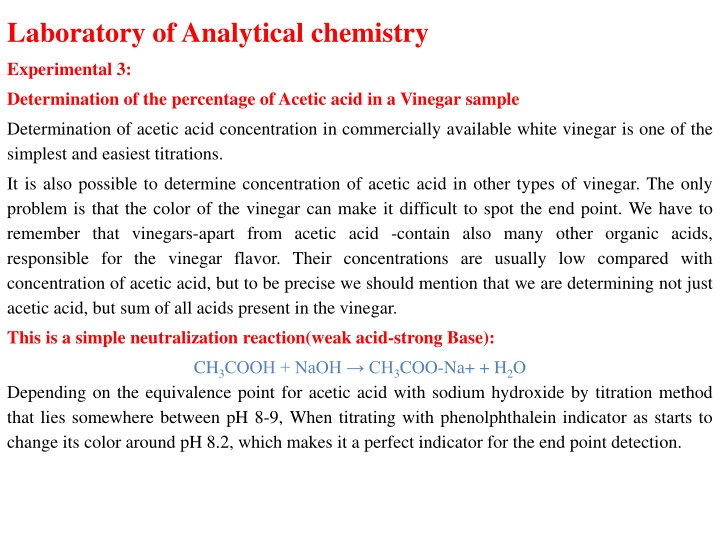
Analytical Chemistry Experimental: Acetic Acid Percentage Determination in Vinegar Sample
Discover how to determine the percentage of acetic acid in vinegar samples through a simple titration method using sodium hydroxide. Learn about the titration curve, procedure, and comparison of calibration curves with strong and weak acids. Get insightful guidance for accurate analytical chemistry experiments.
Download Presentation

Please find below an Image/Link to download the presentation.
The content on the website is provided AS IS for your information and personal use only. It may not be sold, licensed, or shared on other websites without obtaining consent from the author. If you encounter any issues during the download, it is possible that the publisher has removed the file from their server.
You are allowed to download the files provided on this website for personal or commercial use, subject to the condition that they are used lawfully. All files are the property of their respective owners.
The content on the website is provided AS IS for your information and personal use only. It may not be sold, licensed, or shared on other websites without obtaining consent from the author.
E N D
Presentation Transcript
Laboratory of Analytical chemistry Experimental 3: Determination of the percentage ofAcetic acid in a Vinegar sample Determination of acetic acid concentration in commercially available white vinegar is one of the simplest and easiest titrations. It is also possible to determine concentration of acetic acid in other types of vinegar. The only problem is that the color of the vinegar can make it difficult to spot the end point. We have to remember that vinegars-apart from acetic acid -contain also many other organic acids, responsible for the vinegar flavor. Their concentrations are usually low compared with concentration of acetic acid, but to be precise we should mention that we are determining not just acetic acid, but sum of all acids present in the vinegar. This is a simple neutralization reaction(weak acid-strong Base): CH3COOH + NaOH CH3COO-Na+ + H2O Depending on the equivalence point for acetic acid with sodium hydroxide by titration method that lies somewhere between pH 8-9, When titrating with phenolphthalein indicator as starts to change its color around pH 8.2, which makes it a perfect indicator for the end point detection.
Procedure: 1- transfer 10 ml of unknown into 100ml volumetric flask, complete the volume with distilled water, stopper the flask and shake well. 2- transfer with a bulb pipette , 10 ml of the prepared solution to a conical flask. Add 2 drops of (ph.ph) as an indicator. 3- Fill the burette with 0.1 N NaOH solution. 4- titrate the prepared acetic acid solution (diluted unknown) with standard NaOH until the color of the indicator becomes faint pink. 5- The normality of NaOH must be determined by titration with standard HCl (mention before).
H.W: Compare the standard calibration curve when a strong acid is titrated with a strong base and a week acid titrated with a strong base. Lecturer Hussein N.K. AL-Salman
